|

by Freddy Silva
Extracts from
Secrets in the Fields
1997
from
LovelyClara Website
|
Trilling
sounds have often been recorded in connection with crop
circle creation, and experiments with plants and sound
have produced similar effects in the laboratory. |
During the twilight days of December 1998, small articles tucked
away in the nether regions of the British press quietly announced
’Unknown Force Was Behind Corn Circles, Claims Hoaxer’. This
dramatic U-turn by the surviving member of the infamous Doug & Dave
duo- who since 1991 have misled the world with tales of their crop
flattening prowess with planks of wood- illustrates that the hand of
man materialized in crop circle lore long after the real phenomenon
manifested.
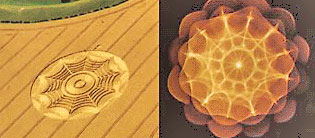
Cymatics images from
Cymatics: A Study of
Wave Phenomena and Vibration
by
Hans Jenny
Latter-day hoaxers claim that they
applied boot to wheat in 1978, yet crop circles have appeared
throughout the world since the early 1900s, with dozens of
eyewitnesses even reporting crop circles forming in a matter of
seconds as far back as 1890; several descriptive accounts were even
documented in 1678 by Robert Plot, then curator of the Ashmolean. If
hoaxers are responsible, then, they appear to have mastered the art
of time travel, in which case it is they who should be under
scientific scrutiny.
To date some 10,000 crop circles have been catalogued worldwide, and
their anomalous features continue to be irreplecatable:
-
plants bent
an inch above soil and gently laid down in geometrically-precise
patterns with no physical signs of damage
-
light burn marks at the
base of stems
-
altered cellular structure and soil chemistry
-
discrepancies in background radiation
-
alteration of the local
electromagnetic field
-
depletion of the local watershed
-
dowsable, long-lasting energy patterns, not to mention measured
effects on the human biological field
So much, then, for two guys
and a piece of wood. But thanks to a virtual embargo on research
coverage throughout the media, a popular myth has developed that all
crop circles have been nothing more than a prank with a plank.
 By
definition, hoaxes are forgeries, and forgeries require originals
from which to copy. So what is this ’unknown force’ that creates
genuine crop circles? One answer may lie with sound. By
definition, hoaxes are forgeries, and forgeries require originals
from which to copy. So what is this ’unknown force’ that creates
genuine crop circles? One answer may lie with sound.
Echoed in all the world’s faiths and traditions, Universal matter
was created by sound: ’In the beginning was the Word, and the Word
was with God’, St. John reminds us.
Hopi and Navajo traditions even
assert that in ancient times
shamans would utter words onto sand and
create patterns, a concept not dissimilar to the Hindu mandalas
which are said to be expressions of the vibration of God.
Consequently, the Eastern faiths- Islam in particular- chose sacred
geometry to express the image of God, a technique later used in
those hymns to
sacred geometry, Gothic cathedrals.
 Modern
science now shows that these geometric rhythms lie at the centre of
atomic structures. When Andrew Gladzewski carried out research into
atomic patterns, plants, crystals and harmonics in music he
concluded that atoms are harmonic resonators, proving that physical
reality is actually governed by geometric arrays based on sound
frequencies. Even that primeval Hindu sound, the OM, from
which is derived our modern term ’hum’, when sung into a tonoscope
produces the very geometric shapes attributed with ’sacredness’. Perhaps the
most important of these shapes is the hexagon, upon which the
Egyptian matrix named the Flower of Life is based. This series of
outwardly-rotating divisions of the circle accommodate the branches
of the building blocks of life, the amino acids. This Flower of Life
has subsequently manifested as a crop circle. Modern
science now shows that these geometric rhythms lie at the centre of
atomic structures. When Andrew Gladzewski carried out research into
atomic patterns, plants, crystals and harmonics in music he
concluded that atoms are harmonic resonators, proving that physical
reality is actually governed by geometric arrays based on sound
frequencies. Even that primeval Hindu sound, the OM, from
which is derived our modern term ’hum’, when sung into a tonoscope
produces the very geometric shapes attributed with ’sacredness’. Perhaps the
most important of these shapes is the hexagon, upon which the
Egyptian matrix named the Flower of Life is based. This series of
outwardly-rotating divisions of the circle accommodate the branches
of the building blocks of life, the amino acids. This Flower of Life
has subsequently manifested as a crop circle.
As the expression of number in space, geometry is inextricably
linked to music since the laws of the former govern the mathematical
intervals that make up the notes in the western music scale- the
diatonic ratios- hence why the ancient Egyptians referred to
geometry as frozen music.
In the February 1992 edition of Science News, Prof.
Gerald Hawkins used the principles
of Euclidean geometry to prove that four theorems can be derived
from the relationships of elements in crop circles. More
significantly, he discovered a fifth theorem from which he could
derive the other four. Despite an open challenge, over half a
million subscribers have been unable to create such a theorem, which
Euclid himself only hinted at twenty-three centuries earlier in his
thirteen treatises on mathematics. So it came as a slight surprise
when its equilateral version materialized as 160,000 sq. ft. of
flattened barley at Litchfield, Hampshire, in 1995.
Since Hawkins’ Euclidean theorems also produce diatonic ratios, a
link exists between crop circles and musical notes, themselves the
by-product of the harmonic laws of sound frequency. Soon, crop
circles bearing unmistakable associations with sound then began to
appear. One contained a curious ratchet feature from which is
constructed a musical diagram also dating to the Egyptians, the Lambdoma. Also known as
the Pythagorean Table, it defines the exact
relationships between musical harmonics and mathematical ratios.
In 1996 another crop circle demonstrated the combination of two
important figures: the 3-4-5 triangle and the Golden Mean, producing
the geometric diagram necessary to produce musical ratios. But it
was a convincing formation at Goodwood Clatford- which had its
plants bent six inches from the top- that gave the proverbial nod to
sound, for here was a representation of a cymatic pattern etched in
5000 sq ft of barley.
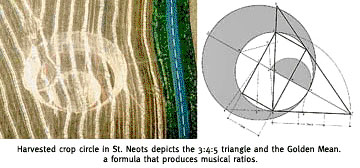 Cymatics
is the study of vibrational wave patterns. One of its earliest
pupils was Margaret Watts-Hughes who, in 1891, captured precise
geometric patterns on film as she sang sustained notes into a device
containing lycopodium powder. But it would be another seventy six
years before Swiss scientist
Hans Jenny published the first of his
painstaking studies on the transmission of sound through physical
mediums, this time in the shape of monitored electronic frequencies. Cymatics
is the study of vibrational wave patterns. One of its earliest
pupils was Margaret Watts-Hughes who, in 1891, captured precise
geometric patterns on film as she sang sustained notes into a device
containing lycopodium powder. But it would be another seventy six
years before Swiss scientist
Hans Jenny published the first of his
painstaking studies on the transmission of sound through physical
mediums, this time in the shape of monitored electronic frequencies.
He observed how sound vibration created geometric shapes- a low
frequency produced a simple circle encompassed by rings, whereas a
higher frequency increased the number of concentric rings around a
central circle. As the frequencies rose so, too, did the complexity
of shapes, to the point where tetrahedrons, mandalas and other
sacred forms could be discerned. Like Margaret before him, Jenny
enabled humanity to observe ’frozen music’.
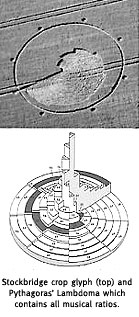 Jenny
also provided a physical connection to the creation of crop circles
since many of the vibrational patterns found in his photos mimic
their designs. Some are blatant imitations, such as the circle
surrounded by concentric rings typical of early 80s patterns, the
tetrahedron at Barbury Castle in 1991, the spider’s web mandala at
Avebury from 1994, even the highly structured star fractals of 1997.
Other photos demonstrate the construction geometry encoded within
the crop circles’ skeleton. Jenny
also provided a physical connection to the creation of crop circles
since many of the vibrational patterns found in his photos mimic
their designs. Some are blatant imitations, such as the circle
surrounded by concentric rings typical of early 80s patterns, the
tetrahedron at Barbury Castle in 1991, the spider’s web mandala at
Avebury from 1994, even the highly structured star fractals of 1997.
Other photos demonstrate the construction geometry encoded within
the crop circles’ skeleton.
Visually, then, there is little room to deny the connection. But
what evidence is there of sound in crop circles at a physical level?
Many accounts exist of a trilling sound heard by people prior to
witnessing crop circles forming. The reports describe a sudden
stillness in the air, the morning birdsong superseded by a trilling
sound and the banging together of wheat heads despite an absence of
wind. A whole section of crop then lays down in spiral fashion, the
whole episode lasting less than fifteen seconds. Circles researcher
Colin Andrews came across the trilling noise himself when, in mild
frustration during his search to find a single answer to the
phenomenon, he beseeched the heavens, "God, if only you could tell
me how these things are created". The reply he received was
eventually captured on magnetic tape. Subsequent analysis at Sussex
University and NASA’s Jet Propulsion Lab concluded the
noise was
mechanical in nature and beating at a frequency of 5.0-5.2 kHz.
Whilst recording an interview inside a crop circle the same sound
was heard by a BBC cameraman shortly before it rendered a £30,000 TV
camera obsolete. Interestingly, when the sound made another
appearance during group research inside another formation it
exhibited qualities of non-linear movement, and behaved in tandem
with specific requests, sometimes on a psychic level. Since it also
has the ability to transmit on radio frequencies and interfere with
electronic equipment, birds and insects can be ruled out; and
although skeptics are quick to accuse that the recorded sound is, in
fact, the grasshopper warbler, stroboscopic analysis of both voice
prints revealed vast differences between this bird and the bizarre
noise. Besides, these birds frequent marshes, not vast, open fields
of cereal crop.
Interestingly, the Aborigines relate to this trilling sound.
During their ceremonies to contact- in their words- the sky spirits,
a ’bora’
consisting of a specially-shaped piece of wood is attached to the
end of a long string and whirled, creating a noise practically
identical to the crop circle hum. One has to wonder where the
inspiration for this device came from, who these sky spirits were,
and what on earth made the timeless Aborigines associate this noise
with them. That was until it was discovered that not only have crop
circles appeared in Australia, many throughout the 1960s, but their
manifestation figures in Aboriginal lore, just as their geometries
appear in rock paintings.
In 1998 sounds of a more melodic kind were heard and recorded inside
a formation by three witnesses (or is it earwitnesses?); the design
was founded on sevenfold geometry, a representation of the intervals
in the diatonic music scale. Several months later I came across a
diagram called the Web of Athena, in which all the points of the
heptagon are connected. Despite the jumble of lines the diagram
consists of just three line lengths, and by juxtaposing these onto a
stringed instrument, the exact same notes were recreated.
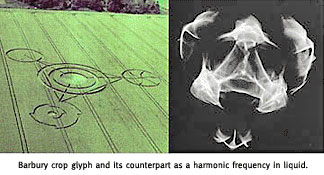 But
perhaps the greatest connection linking sound to the manifestation
of crop circles lies in their greatest anomaly: the permanent
bending of the plants’ stems. In Canada during the 1960s, laboratory
experiments measured the effects of music on plants by subjecting
them to different tones. Exposure to heavy metal music made the
plants tilt in the opposite direction, whereas classical music
lulled the plants toward the speakers. But in the case of Hindu
devotional music -and the songs of Ravi Shankar, in particular- the
stems bent in excess of 60º to the horizontal, perhaps the closest
any human has ever come anywhere to achieving that right angle
common to genuine crop circles. But
perhaps the greatest connection linking sound to the manifestation
of crop circles lies in their greatest anomaly: the permanent
bending of the plants’ stems. In Canada during the 1960s, laboratory
experiments measured the effects of music on plants by subjecting
them to different tones. Exposure to heavy metal music made the
plants tilt in the opposite direction, whereas classical music
lulled the plants toward the speakers. But in the case of Hindu
devotional music -and the songs of Ravi Shankar, in particular- the
stems bent in excess of 60º to the horizontal, perhaps the closest
any human has ever come anywhere to achieving that right angle
common to genuine crop circles.
Further experiments at Annamalai University applying Indian
devotional song generated additional effects:
-
the number of stomata
in the experimental plants was 66% higher
-
the epidermal walls were
thicker
-
the palisade cells were longer and broader than control
specimens, sometimes by as much as 50%
Similar biophysical changes
are known to occur in plants collected from crop circles. Tests
performed since 1989 by American physicist Dr. W. Levengood
consistently show how the energy creating crop circles is able to
affect seed embryo and plant growth, elongate the plant’s nodes,
even alter the pattern of the chromosomes themselves.
Yet the effect extends beyond plants. Agricultural researcher George
Smith found that exposing corn to sound frequencies produced a
higher heat content in soil, as well as a slight burnt appearance in
the plants. The effect is consistent with the slight ’baking’
regularly observed in crop circles, where the affected area appears
noticeably drier than the rest of the field despite overnight rain;
the same applies to the ’slight burning’ at the base of crop circle
stalks. Oddly enough, Smith speculated at the time that sound energy
also increased molecular activity in plants, three decades before it
was found in crop circle samples by Levengood.
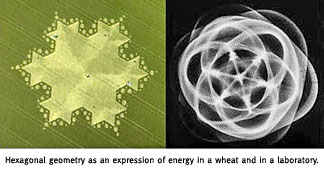 Since
a sudden and abnormal burst of growth is also known to occur in crop
circle plants it was postulated that microwave was the culprit
behind the creation of crop circles. However, microwave has the
ability to render biological systems sterile, and a certain dose
will even kill organisms. Yet the crop circles plants are alive and
well. After four years of experiments on regular wheat at the
University of Ottawa, Mary Measures and Pearl Weinberger found
accelerated growth in laboratory samples, and postulated that the
sound frequency they applied had produced a resonant effect in the
plants’ cells, thereby affecting their metabolism. The frequency
Measures and Weinberger applied was identical the crop circle
trilling noise. Since
a sudden and abnormal burst of growth is also known to occur in crop
circle plants it was postulated that microwave was the culprit
behind the creation of crop circles. However, microwave has the
ability to render biological systems sterile, and a certain dose
will even kill organisms. Yet the crop circles plants are alive and
well. After four years of experiments on regular wheat at the
University of Ottawa, Mary Measures and Pearl Weinberger found
accelerated growth in laboratory samples, and postulated that the
sound frequency they applied had produced a resonant effect in the
plants’ cells, thereby affecting their metabolism. The frequency
Measures and Weinberger applied was identical the crop circle
trilling noise.
Sound as one energy source capable of creating crop circles now
becomes very feasible. But what type of sound coaxes plants to bend
and lie down, applying firm and gentle pressure and, given the
intricacy and complexity of latter-day patterns, with a fine degree
of control?
Interestingly, ultrasound is capable of interacting with physical
elements to such an incredible degree. It can be aimed, focused and
reflected almost like a light beam, and specific frequencies can be
focused to cause certain kinds of molecules to vibrate while others
nearby are left unmoved. The higher the frequency of ultrasound, the
greater its ability to be directed. This requires frequencies in the
high MHz range, such as those detected in crop circles by Paul Vigay.
His empirical data shows how the level of background readings drop
abruptly when he crosses the threshold of a formation. Close to the
centre, readings hover in the vicinity of 260-320 MHz.
However, just as crop circles have made a quantum leap in
mathematical complexity over the past two years, so readings have
recently jumped to 540 MHz. Incredibly, this coincides with
Jenny’s
experiments which show that a relationship exists between the rising
complexity of cymatic geometries in proportion to the rise of
dispensed frequency. In other words, the level of frequency, whether
in a laboratory or a field, correlates with the increase in design
intricacy.
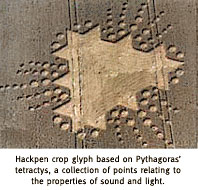 Such
extremely high frequencies are known to affect the state of
awareness and consciousness in humans. Interestingly, people
visiting crop formations often notice this, where even simple left
brain functions such as counting are affected. When tuned in the MHz
range ultrasound also prevents damage to sensitive tissues, so its
healing properties are used in treating muscular ailments, and cases
of people reporting healings when inside crop circles are becoming
commonplace. One long-time sufferer of Parkinson’s Disease reported
being cured overnight. Such
extremely high frequencies are known to affect the state of
awareness and consciousness in humans. Interestingly, people
visiting crop formations often notice this, where even simple left
brain functions such as counting are affected. When tuned in the MHz
range ultrasound also prevents damage to sensitive tissues, so its
healing properties are used in treating muscular ailments, and cases
of people reporting healings when inside crop circles are becoming
commonplace. One long-time sufferer of Parkinson’s Disease reported
being cured overnight.
Below 20 Hz sound becomes infrasonic, and such frequencies are
directly involved with biological processes. It is well known that
long exposure to infrasound can cause unpleasant conditions such as
fatigue and nausea, and such symptoms are reported by visitors to
crop circles. When combined with high-pressure, the acoustic power
created by infrasound is in the order of kilowatts. In the case of
plants, this pressure boils the water held inside the stems in a
nanosecond. As water heats it expands, and a close look at crop
circle plants reveals tiny holes in their nodes where this
superheated water has escaped. With a hollow cavity near the base,
and the stems made subtle like molten glass by the heat, the now
top-heavy plants collapse into their new horizontal position.
Since this ’vapour cavitation’ also creates local temperature
increases of hundreds of thousands of degrees for a fraction of a
second it is not now difficult to see why millions of gallons of
groundwater disappear within the area of a crop circle, or why the
plants have a cooked, malty odour. Combine this with Levengood’s
discovery of microscopic blow-holes in the plants’ cell wall pits
(indicating the rapid boiling of water inside the plant), and
everything starts to fall into place.
This infrasonic/ultrasonic process also creates a hissing sound, and
if you are fortunate enough to visit a crop circle within a few
hours of its appearance you will find yourself surrounded by this.
Since infrasound is also capable of atomizing water molecules and
creating a fine mist, it should be mentioned that in 1996 a farmer
out harvesting his field at Etchilhampton saw what he describes as
’a series of columns of mist rising like cannon-shot from the field
next door’. Mist looks very out-of-place in a wheat field, in
mid-afternoon on a dry, summer’s day. Yet shortly after the incident
a series of thirteen circles connected by a three quarter-mile long
avenue and a Sanskrit-type glyph appeared in the very same field.
Finally, vapour cavitation is accompanied by a sudden spark of light
called sonoluminescence, caused by the production of electrical
discharges as the water/vapour is ionized. And the lower the
operating frequency, the greater the effect. In a laboratory, 18 Hz
has been used as the lowest safety threshold below which the
pressure formed by infrasound is known to produce disruption to
chromosomes. Every summer, crop circle plants of every variety are
sent blind to Dr. Levengood, and some inevitably show unmistakable
disruption to their chromosomes. Yet give him samples deliberately
produced by field forgers and he’ll find something really
unusual-perfectly normal plants.
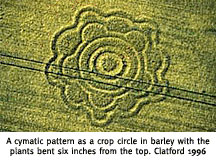 The
musical scale, constructed on the harmonics of sacred geometry, and
now found within the framework of crop circles, represents the
mathematical structure of the soul of the world because it embodies
the essence of the Universe. So it’s no coincidence that a large
percentage of crop circles can be identified with -and by- ancient
cultures, who to this day honour their histories through song and
music, their healing rituals performed with sound or rhythm. This
relationship is further extended in Buddhist mandalas, whose
elaborate geometries are used to alter states of consciousness.
Perhaps it is not by coincidence that crop circle designs mirror
these intricate patterns, just as they bear an uncanny familiarity
to Jenny’s materializations of sound. The
musical scale, constructed on the harmonics of sacred geometry, and
now found within the framework of crop circles, represents the
mathematical structure of the soul of the world because it embodies
the essence of the Universe. So it’s no coincidence that a large
percentage of crop circles can be identified with -and by- ancient
cultures, who to this day honour their histories through song and
music, their healing rituals performed with sound or rhythm. This
relationship is further extended in Buddhist mandalas, whose
elaborate geometries are used to alter states of consciousness.
Perhaps it is not by coincidence that crop circle designs mirror
these intricate patterns, just as they bear an uncanny familiarity
to Jenny’s materializations of sound.
If sound vibrations are both encoded into and generated by crop
circles, is it not possible that they, too, can arouse the
individual at a spiritual level? After all, it’s through music that
whole human experiences are celebrated and carried from generation
to generation. It is very probable that it is for this reason that
the very shape of the human ear -more specifically the cochlea- is a
spiral constructed according to the harmonic laws of tone, just as
the same spiral forms the primary basis from which thousands of crop
circles have sprung.
Music is a carrier for social change. The effects of Handel’s music
is believed to have reversed the state of morality in Victorian
England, just as the anarchic overtones of Punk corralled
disillusioned youth into fighting an establishment that held no
tolerance for those who stepped outside the system. The effects in
people’s states of awareness through contact with crop circles is
similarly documented. In 1990 a pictogram at Alton Barnes sported
the trident of Shiva the Transformer. Ironically, it was through
exposure to this crop circle that millions around the world were
transformed, just as images of crop circles today continue to
enlighten the awareness of those who come into contact with them.
If sound is one of the formative principles behind crop circles, it
is not surprising that they are leaving psychological impressions on
those whose antenna is extended and receptive to their tune.
|


 By
definition, hoaxes are forgeries, and forgeries require originals
from which to copy. So what is this ’unknown force’ that creates
genuine crop circles? One answer may lie with sound.
By
definition, hoaxes are forgeries, and forgeries require originals
from which to copy. So what is this ’unknown force’ that creates
genuine crop circles? One answer may lie with sound. Modern
science now shows that these geometric rhythms lie at the centre of
atomic structures. When Andrew Gladzewski carried out research into
atomic patterns, plants, crystals and harmonics in music he
concluded that atoms are harmonic resonators, proving that physical
reality is actually governed by geometric arrays based on sound
frequencies. Even that primeval Hindu sound, the OM, from
which is derived our modern term ’hum’, when sung into a tonoscope
produces the very geometric shapes attributed with ’sacredness’. Perhaps the
most important of these shapes is the hexagon, upon which the
Egyptian matrix named the Flower of Life is based. This series of
outwardly-rotating divisions of the circle accommodate the branches
of the building blocks of life, the amino acids. This Flower of Life
has subsequently manifested as a crop circle.
Modern
science now shows that these geometric rhythms lie at the centre of
atomic structures. When Andrew Gladzewski carried out research into
atomic patterns, plants, crystals and harmonics in music he
concluded that atoms are harmonic resonators, proving that physical
reality is actually governed by geometric arrays based on sound
frequencies. Even that primeval Hindu sound, the OM, from
which is derived our modern term ’hum’, when sung into a tonoscope
produces the very geometric shapes attributed with ’sacredness’. Perhaps the
most important of these shapes is the hexagon, upon which the
Egyptian matrix named the Flower of Life is based. This series of
outwardly-rotating divisions of the circle accommodate the branches
of the building blocks of life, the amino acids. This Flower of Life
has subsequently manifested as a crop circle. Cymatics
is the study of vibrational wave patterns. One of its earliest
pupils was Margaret Watts-Hughes who, in 1891, captured precise
geometric patterns on film as she sang sustained notes into a device
containing lycopodium powder. But it would be another seventy six
years before Swiss scientist
Cymatics
is the study of vibrational wave patterns. One of its earliest
pupils was Margaret Watts-Hughes who, in 1891, captured precise
geometric patterns on film as she sang sustained notes into a device
containing lycopodium powder. But it would be another seventy six
years before Swiss scientist
 Jenny
also provided a physical connection to the creation of crop circles
since many of the vibrational patterns found in his photos mimic
their designs. Some are blatant imitations, such as the circle
surrounded by concentric rings typical of early 80s patterns, the
tetrahedron at Barbury Castle in 1991, the spider’s web mandala at
Avebury from 1994, even the highly structured star fractals of 1997.
Other photos demonstrate the construction geometry encoded within
the crop circles’ skeleton.
Jenny
also provided a physical connection to the creation of crop circles
since many of the vibrational patterns found in his photos mimic
their designs. Some are blatant imitations, such as the circle
surrounded by concentric rings typical of early 80s patterns, the
tetrahedron at Barbury Castle in 1991, the spider’s web mandala at
Avebury from 1994, even the highly structured star fractals of 1997.
Other photos demonstrate the construction geometry encoded within
the crop circles’ skeleton. But
perhaps the greatest connection linking sound to the manifestation
of crop circles lies in their greatest anomaly: the permanent
bending of the plants’ stems. In Canada during the 1960s, laboratory
experiments measured the effects of music on plants by subjecting
them to different tones. Exposure to heavy metal music made the
plants tilt in the opposite direction, whereas classical music
lulled the plants toward the speakers. But in the case of Hindu
devotional music -and the songs of Ravi Shankar, in particular- the
stems bent in excess of 60º to the horizontal, perhaps the closest
any human has ever come anywhere to achieving that right angle
common to genuine crop circles.
But
perhaps the greatest connection linking sound to the manifestation
of crop circles lies in their greatest anomaly: the permanent
bending of the plants’ stems. In Canada during the 1960s, laboratory
experiments measured the effects of music on plants by subjecting
them to different tones. Exposure to heavy metal music made the
plants tilt in the opposite direction, whereas classical music
lulled the plants toward the speakers. But in the case of Hindu
devotional music -and the songs of Ravi Shankar, in particular- the
stems bent in excess of 60º to the horizontal, perhaps the closest
any human has ever come anywhere to achieving that right angle
common to genuine crop circles. Since
a sudden and abnormal burst of growth is also known to occur in crop
circle plants it was postulated that microwave was the culprit
behind the creation of crop circles. However, microwave has the
ability to render biological systems sterile, and a certain dose
will even kill organisms. Yet the crop circles plants are alive and
well. After four years of experiments on regular wheat at the
University of Ottawa, Mary Measures and Pearl Weinberger found
accelerated growth in laboratory samples, and postulated that the
sound frequency they applied had produced a resonant effect in the
plants’ cells, thereby affecting their metabolism. The frequency
Measures and Weinberger applied was identical the crop circle
trilling noise.
Since
a sudden and abnormal burst of growth is also known to occur in crop
circle plants it was postulated that microwave was the culprit
behind the creation of crop circles. However, microwave has the
ability to render biological systems sterile, and a certain dose
will even kill organisms. Yet the crop circles plants are alive and
well. After four years of experiments on regular wheat at the
University of Ottawa, Mary Measures and Pearl Weinberger found
accelerated growth in laboratory samples, and postulated that the
sound frequency they applied had produced a resonant effect in the
plants’ cells, thereby affecting their metabolism. The frequency
Measures and Weinberger applied was identical the crop circle
trilling noise. Such
extremely high frequencies are known to affect the state of
awareness and consciousness in humans. Interestingly, people
visiting crop formations often notice this, where even simple left
brain functions such as counting are affected. When tuned in the MHz
range ultrasound also prevents damage to sensitive tissues, so its
healing properties are used in treating muscular ailments, and cases
of people reporting healings when inside crop circles are becoming
commonplace. One long-time sufferer of Parkinson’s Disease reported
being cured overnight.
Such
extremely high frequencies are known to affect the state of
awareness and consciousness in humans. Interestingly, people
visiting crop formations often notice this, where even simple left
brain functions such as counting are affected. When tuned in the MHz
range ultrasound also prevents damage to sensitive tissues, so its
healing properties are used in treating muscular ailments, and cases
of people reporting healings when inside crop circles are becoming
commonplace. One long-time sufferer of Parkinson’s Disease reported
being cured overnight. The
musical scale, constructed on the harmonics of sacred geometry, and
now found within the framework of crop circles, represents the
mathematical structure of the soul of the world because it embodies
the essence of the Universe. So it’s no coincidence that a large
percentage of crop circles can be identified with -and by- ancient
cultures, who to this day honour their histories through song and
music, their healing rituals performed with sound or rhythm. This
relationship is further extended in Buddhist mandalas, whose
elaborate geometries are used to alter states of consciousness.
Perhaps it is not by coincidence that crop circle designs mirror
these intricate patterns, just as they bear an uncanny familiarity
to Jenny’s materializations of sound.
The
musical scale, constructed on the harmonics of sacred geometry, and
now found within the framework of crop circles, represents the
mathematical structure of the soul of the world because it embodies
the essence of the Universe. So it’s no coincidence that a large
percentage of crop circles can be identified with -and by- ancient
cultures, who to this day honour their histories through song and
music, their healing rituals performed with sound or rhythm. This
relationship is further extended in Buddhist mandalas, whose
elaborate geometries are used to alter states of consciousness.
Perhaps it is not by coincidence that crop circle designs mirror
these intricate patterns, just as they bear an uncanny familiarity
to Jenny’s materializations of sound.